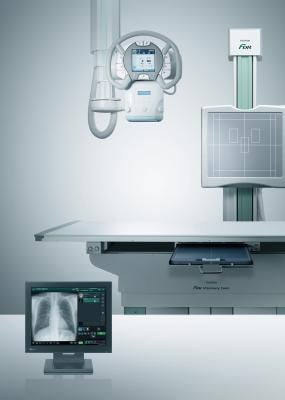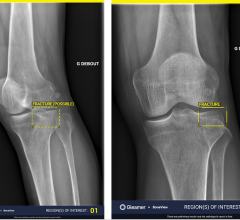
December 17, 2015 — Fujifilm Medical Systems U.S.A. Inc. introduced the FDR Visionary Suite, a next-generation automatic positioning digital radiographic (DR) X-ray room system—at the 101st annual meeting of the Radiological Society of North America (RSNA), Nov. 29 – Dec. 4, 2015, in Chicago.
The new flagship system was designed to optimize imaging workflow while improving diagnostic capabilities. A flexible fully automated positioning DR room system allows technologists to focus on the patient.
The system also features advanced imaging applications including automated long length imaging, dual energy subtraction (DES) and tomosynthesis. FDR Visionary Suite’s auto positioning system lets the technologist simply select the exam and the system repositions its overhead tube to the preferred table or wall-stand and SID for that exam, even mapping the optimal dose techniques. The end result is a faster, more precise and reproducible exam with less chance of repeats for a better overall patient experience.
The system will be scalable and configurable with Fujifilm’s existing FDR D-EVO detectors and a new detector called FDR D-EVO Advance, denoting its advanced applications acquisition technology. The new cesium iodide (CsI) detector featuring ISS, is a 17x17” format size, features a built-in handle, can be used wirelessly for cross table exams and automatically plugs in for integrated wired connection, charging and high speed image transfer when inserted into the bucky tray of the table or upright.
FDR Visionary Suite’s advanced applications extend its diagnostic capabilities beyond conventional 2-D radiographic imaging for challenging views and higher detail imaging. Included below is a summary of each advanced application:
- Automated long length stitching capability captures DR images for whole spine and long leg imaging, acquiring up to a 63” view in as little as 9 seconds. This functionality is complimented with Fujifilm’s intelligent image processing which automatically adjusts contrast between images and corrects misalignment from slight patient movements. The end result is fast, easy long length images that help minimize patient positioning discomfort and optimized images that help eliminate repeat exams;
- The tomosynthesis application produces up to 60 image slices in as little as 12 seconds from a single sweep of the X-ray tube to provide a deeper rendering of the anatomy to clarify small and obscured fractures at a fraction of the dose and cost of a computed tomography (CT) scan; and
- Dual energy subtraction acquires two rapid exposures at different energy levels to produce three images — traditional, soft tissue and bone-only views — to help differentiate foreign objects, soft tissue and calcified structures. Fujifilm complements this application with sophisticated motion correction to suppress cardiac, lung and other misalignment distortions, along with density and noise compensation, which further improve clarity and sharpness.
For more information: www.fujifilmhealthcare.com


 March 19, 2025
March 19, 2025 








